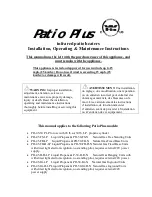
11
GENERAL MAINTENANCE
Soot:
Where the flames impact the logs, a black sooty carbon buildup will occur. This is normal and what a lot of people
feel adds to the realism of the log set. There are several soot cleaners on the market that can be used to clean off the
excess soot. The logs can also be brushed with a soft bristled brush when they are cool.
Note: The logs will not come 100
percent clean and will still show signs of soot even after cleaning.
Grate:
The fireplace grate is made out of a painted steel and will show signs of heat stress over time. The grate can be
re-painted with a high heat fireplace paint to restore it to its original condition. Sand away any rust before painting.
Embers:
Over time, the glowing ember material will lose its glow and need to be replenished and replaced. This can be
accomplished by simply adding some additional embers to the ember bed or removing all existing embers and replacing
them fully.
Sand:
Replace the sand in your burner should you lose some during maintenance. Should moisture pack down and
compress the sand, stir it gently with a long handled screwdriver to loosen the material.
Venting System:
You should have the venting system of your fireplace inspected annually, cleaned if necessary, and any
repairs conducted. This should be done by a qualified agency or a certified chimney sweep. Only use this vented gas log
set in a fully functioning fireplace and chimney in good repair.
TROUBLESHOOTING
WARNING
It is critical that your fireplace vent all products of combustion. Signs that your venting is inadequate include but are not
limited to: any smoke or odors noticed in the room, soot at the top of the fireplace opening, soot directly above the
fireplace, soot on the underside of the fireplace mantel, and/or soot anywhere in the room. Discontinue use of the gas
log set immediately until the issue has been properly corrected by a certified chimney professional.
Sooting on logs:
Some sooting of the logs can be expected but excessive sooting can be caused by the following items:
high gas pressure; logs may be placed tightly together not allowing a path for fire and draft to move through; or
fireplace venting system not drafting properly*.
Discontinue using the fireplace and consult a fireplace professional.
*Note: In cold climates, preheat the flue by running the logs on low for a while to establish draft, drafts/competing
sources of air in the home, something in the vent or an issue with the flue cap could be preventing draft.
Noise from burner:
Caused by sharp bends in gas line, potentially could be debris in orifice fitting or the burner itself.
Low flame:
Orifice fitting has blockage or lack of gas supply/pressure.
High flame:
When included orifice fitting is not installed on the burner, gas supply feed may be too high. LP gas used on
a natural gas burner, may cause a high flame. Confirm correct gas pressure.
Odors:
Gas leak may be present.
SHUT GAS OFF IMMEDIATELY!
Stop use of gas log until the leak is corrected. Other
issues may cause odors, such as the venting system being closed, blocked or inadequate. Paint or other contaminants
may have been pulled into the fireplace and burned. Discontinue use of the gas log set until the fireplace is inspected by
a fireplace professional.
Carbon monoxide detector alarm sounding:
Discontinue use of the gas log set and have your fireplace venting system
inspected. Competing house systems in the home including kitchen venting, heating systems, etc. can also pull air from
the fireplace and affect the natural draft of the log set. Turn off the gas log set and leave the home, leaving doors and
windows open to allow the home to vent fresh air. Discontinue use of the gas log set until the fireplace is inspected by a
fireplace professional.






























